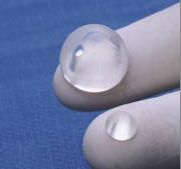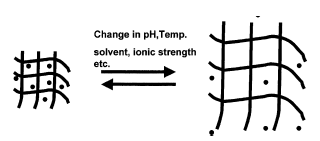A notable feature of the gastrointestinal tract is its well-defined acidity gradient, starting in the harsh stomach and steadily tapering toward neutral in the colon. By creating a polymer that automatically responds to acidity, researchers are develop drug delivery methods that passively target specific locations in the GI tract.
The term “smart polymer” has been used to broadly describe any type of polymer system that reacts beneficially without human intervention—for example, self-healing structural plastics. Within the realm of drug delivery, a smart polymer is one that has a drastic reaction to a small change in bodily stimuli, such as temperature, pH, or the presence of a chemical.
 Hydrogels, as seen in the photo, are polymer networks filled water. They can also trap cargo chemicals within their filaments. A chemist creates a pH-sensitive hydrogel by adding acidic or basic functional groups to the backbone of its polymer component. This produces a polymer molecule that acts as an acid or a base, releasing or accepting protons in response to the pH of its surroundings. The transfer of protons also implies the accumulation of a charge in the polymer molecule.
Hydrogels, as seen in the photo, are polymer networks filled water. They can also trap cargo chemicals within their filaments. A chemist creates a pH-sensitive hydrogel by adding acidic or basic functional groups to the backbone of its polymer component. This produces a polymer molecule that acts as an acid or a base, releasing or accepting protons in response to the pH of its surroundings. The transfer of protons also implies the accumulation of a charge in the polymer molecule. When a sufficient amount of charge has built up, the polymer filaments repel each other, resulting in expansion. What we see is a drastic change in the volume; what the cargo drug sees is an easy escape route through newly-enlarged polymer pores.
The presence of acid causes a base-enabled polymer will accept protons, become positively charged, and drop its chemical cargo. This means that a pH-responsive polymer can be used to selectively deliver drugs in areas characterized by unusual extremes in pH—for example, the acidic extracellular matrix around tumor cells. By controlling the number and type of acid or basic functional groups, the designer of a smart polymer can fine-tune the sensitivity of the polymer, defining a range of pH that excludes high-acid areas such as the stomach.

In a system with a well-defined acidic gradient, such as the gastrointestinal tract, a smart polymer can be used to deliver medical cargo at a location defined by its pH. This is a boon to the treatment of intestinal diseases such as Crohn’s disease and colitis—a smart polymer coating protects the stomach from the drugs, and vice-versa.
The simplicity of intelligent polymers provides a stark contrast to the recent buzz over the intelligent pill. Royal Philips Electronics's iPill also makes use of the acidic gradient to guide intestinal medication, but their take on the smart pill has more in common Star Trek's nannites than a savvy gelcap. Combining acid sensors, drug delivery mechanisms, signal transmitters and a 2-day battery into a disposable tablet, the iPill delivers a course of drugs to the GI tract before passing through system into oblivion. While there is some wicked joy in the idea of swallowing the medical equivalent of an iPhone, the intense active control granted by Philips’ pill may be overkill for straightforward intestinal maladies. Look for smart polymers in the over-the-counter options.
"Responsive polymers in controlled drug delivery". A.K. Bajpai, Sandeep K. Shukla, Smitha Bhanu, Sanjana Kankane. Progress in Polymer Science 33 (2008) 1088–1118
"Thermo- and pH-responsive polymers in drug delivery". Dirk Schmaljohann. Advanced Drug Delivery Reviews 58 (2006) 1655–1670
The iPill, in the New York Times, January 31, 2009: <http://www.nytimes.com/2009/02/01/business/01novel.html>




Comments